Where Art Meets Engineering: Google Art Project

The work of art in the age of Google: one tech giant's attempt at bringing disruptive technologies and culture together for the greater good.
Since the late 80s, art museum personnel have wondered how best to use the internet to complement their institutions’ mission to conserve, proliferate and interpret works of culture. In 2010, a small group of art-enthusiasts at a tech giant called Google got together as part of a 20% project to aggregate art from global museums onto one digital platform. This ‘hobby’ project was eventually launched in 2011 as The Google Art Project, a non-profit initiative that collaborated with 17 international partners including the Tate Gallery, the Metropolitan Museum of Art, and the Uffizi Gallery (1) to reproduce and host one one-gigapixel artwork from each museum, including landmark pieces such as The Starry Night by Vincent Van Gogh.
The Gigapixel Treatment
The Art Project has accomplished a synergy between art and engineering with its unparalleled use of the internet and digitisation to enable a seamless transition from gallery to computer screen. It is now available in 18 languages, and features collections outside of fine arts, including the Yad Vashem (2), and architectural sights like the Sydney Opera House. The platform’s capabilities have expanded- allowing users to virtually tour entire galleries, and a microscope view that allows a user to zoom in to images for greater detail than is visible to the naked eye. (3)
Zoom into works of art (Credit: Van Gogh Museum/Google Art Project)
This has been accomplished with the use of technologies like Google Maps and Street View and tools built specifically for the Project. Once the ultra-high resolution images of artworks or spaces are captured, software and GPS is used to stitch these images with museum floor plans- enabling users to switch from Google Maps, into Google Street View and look inside the Partner’s gallery. (4) The platform also incorporates into its exhibits partner institution-provided and/or Google-provided resources—which include Google Scholar and YouTube- that allow users access to additional educational content about that particular work. Recent iterations have enhanced search capabilities and features that allow users to use their Google accounts to build their own virtual private collection. (5)
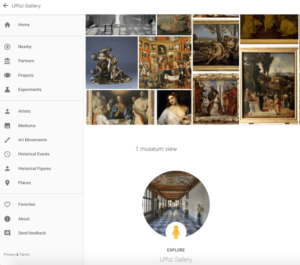
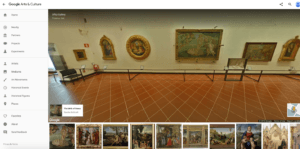 Use of Street View Technology to enable interactive virtual tours (Credit: Birth of Venus by Sandro Botticelli, Uffizi Museum/Google Art Project)
Use of Street View Technology to enable interactive virtual tours (Credit: Birth of Venus by Sandro Botticelli, Uffizi Museum/Google Art Project)
Additional resources available in the form of video and text content (Credit: Yad Vashem/Google Art Project)
The Art Project has been praised for its role in democratisation of knowledge (6) by enabling audiences and scholars who would otherwise be unable to visit these museums due to barriers of cost or location to tour some of the greatest cultural exhibits in the world. The Project also now allows users contribute their own content, adding their insight to the public collection of knowledge. Initially, museum administrations had concerns that opening up collections to digital availability would hurt museum attendance and create copyright and commercialisation issues- that Google would try to monetise and profit from these exhibits. These were eventually put to rest by two factors- firstly, Google signs contracts with museums that pledge not use the content for commercial gain. Additionally, research has shown that digital transformation of art has in fact increased museum traffic. (7) For example, within two weeks of the Art Project launch, MoMA reported a 7% increase in its website traffic and increases in ticketing . This is because nothing actually beats a first person experience- and what the Project tries to do at its very core, is complement real-time visits and convince viewers to experience this first hand. (8) On the whole, the Project has proved to be a reassuring lesson on the benefits of digitisation for its institutional partners.(9)
Van Gogh made three separate paintings of his bedroom in Arles which reside at three locations. The Project allows visitors to create and share a gallery where these paintings can be viewed side by side; and includes links to their respective museum collections. Imagine the academic impact of online galleries that have commentary from curators at multiple institutions. Users can add personal inputs as well. (Credit: Google Art Project)
Way Forward: Democratising Further and Unifying Experiences
Critics have argued that the Project provides a largely Western-biased representation of art. Google and their institutional partners decide on what they will make available, and the onus falls to them to be as representative as possible. While it has remedied this issue to a certain extent recently, the Project must continue to use its advantage of immense dissemination potential to bring indigenous and traditional art works to the fore. In addition, works at the moment are all iconic- but as an archival tool, it would be of greater value for the Project to digitise temporary exhibitions to maintain a permanent record of works that were borrowed and assembled from various collections for a particular academic purpose. Google should also work towards expanding to a seamless in-museum experience with its institutional partners to eliminate the need for printed collateral and improve sustainability- imagine a system where you point your phone at an art work and get information in the form of an overlay! Moreover, to further the future of online collections Google needs to invest in creating connections between materials held by different institutions and integrate social-networking technologies that replace the “empty room” feel of the current system with interaction between other virtual museum-goers. (10)
Steps towards democratisation and diversity of representation (Credit: Google Art Project)
Either way, the Art Project has shown us the magic that happens when the internet and cultural institutions work together. The only question that exists now is that will museums cross that barrier and begin thinking more disruptively about sharing more of their resources with such platforms?
Sources
- http://www.telegraph.co.uk/culture/8296365/The-best-online-culture-archives.html
- http://www.yadvashem.org/yv/en/pressroom/pressreleases/pr_details.asp?cid=664
- http://thenextweb.com/google/2012/04/03/googles-art-project-grows-larger-with-151-museums-online-across-40-countries/
- https://googleblog.blogspot.com/2011/02/explore-museums-and-great-works-of-art.html
- https://www.google.com/culturalinstitute/about/users/
- https://www.edge.org/3rd_culture/sanger07/sanger07_index.html
- http://www.newyorker.com/culture/cultural-comment/alone-virtual-museum
- http://www.nytimes.com/2014/10/26/arts/artsspecial/the-met-and-other-museums-adapt-to-the-digital-age.html
- http://www.telegraph.co.uk/culture/art/art-news/8296251/The-problem-with-Googles-Art-Project.html
- http://www.washingtonpost.com/wp-dyn/content/article/2011/02/01/AR2011020106442_2.html?sid=ST2011020103688
(797 words, excluding headings)


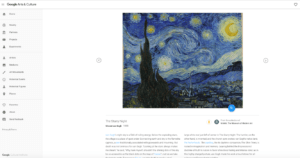
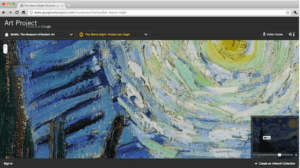

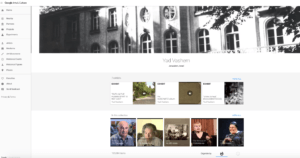
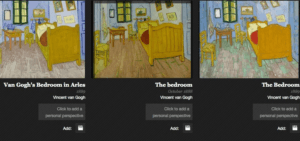
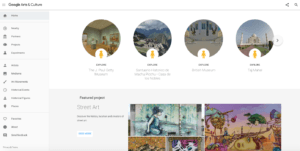
Interesting post Deepa! Google does so many things that it is hard to keep track of all they do. I had no idea they were working on “democratisation” of art. For so long, countries and museums had monopolies over the art pieces. Museums in their current form are so inaccessible to so many people across the world. In my opinion, this integration of a cultural institution and technology should further proliferate the arts and culture in our society. It should be a win-win for both google and the cultural institution.
Thanks for the interesting post, Deepa. I love how Google is using its technology for the greater good and without intent of monetization. I found it very interesting that you pointed out that the Google Art Project is not cannibalizing traffic away from the art galleries – on the contrary. The Economist wrote about the project a while ago, mentioning (in line with your statement) that “Looking through the Google Art Project is a bit like walking by a bakery, smelling the brownies and shoving your nose against the glass. It intensifies the hunger rather than quashing it.” [1]
I also wonder whether the Google Art Project will help make art for young people in particular more accessible and interesting. I think it’s great that people can look at art from their sofa at home; but furthermore, I think it is great that it augments the on-site museum experience through the ability to access information and educational content about the painting as you stand in front of it. That should connect well with millennials, who are used to being on the phone at all times and accessing information through their smartphones. I wonder whether there are other ways Google could implement to make classic art more “cool”, such as implementing more social features. Some studies show [2] that millennials prefer social media to discover art, rather than visiting a gallery.
[1] The Economist. 2016. Google Art Project: Getting in close and impersonal | The Economist. [ONLINE] Available at: http://www.economist.com/blogs/prospero/2011/02/google_art_project. [Accessed 19 November 2016].
[2] Study: U.S. Millennials Prefer Instagram to Museums; Purchase & Discover Art Online | Business Wire. 2016. Study: U.S. Millennials Prefer Instagram to Museums; Purchase & Discover Art Online | Business Wire. [ONLINE] Available at: http://www.businesswire.com/news/home/20160413005960/en/Study-U.S.-Millennials-Prefer-Instagram-Museums-Purchase. [Accessed 19 November 2016].
Very interesting topic! I’ve never heard of the Google Art Project before but I definitely plan to use it to check out museum collections before visiting. While it’s nice to feature classic pieces such as Starry Night, I think the real value of the Project may lie in emerging artists’ work that is less accessible by the masses. This can be achieved by partnering with smaller galleries that feature local artists. I would also love to see Google partner with Oculus to provide Virtual Reality (VR) tours through the Project. Perhaps users at home can put on their Oculus and experience one section of a gallery, this teaser will prompt people to get excited about the gallery experience and purchase tickets to visit in person.
What a great way for Google to leverage its engineering talent and reach to make art accessible to all. I do think the implementation was a very key element to making this a successful project. The fact that Google was able to capture the layout of the museum is hugely important in both getting the buy-in from museum partners as well as providing virtual visitors with as full an experience as possible. Had Google just given its virtual visitors a dump of art pieces through which to browse, the amount of thought with which museum layouts are constructed would have been entirely lost in the experience. I also really appreciated your recommendation of investing in technology to enhance the in-museum experience. Great post!
Thank you for your post. I agree with you that this platform is a democratization of knowledge and has many applications. It seems like this platform could really complement the way schools teach art. In many cases, schools are too far away from many of the iconic museums and galleries and by using the Google Art Project, students have the ability to “walk through” the galleries to see the paintings that they have been learning about. Despite the fact that they are not physically at the site, there is a tangibility factor that makes the learning more interactive. Additionally, I believe smaller galleries could benefit from using this platform as well. Small galleries have had difficulties expanding their collector base and have failed to innovate their business models [1]. By incorporating their pieces onto the Google Art Project, these small galleries increase exposure to potential new customers and can give them the infrastructure needed to really compete on a digital level.
[1] https://www.bloomberg.com/news/articles/2015-07-30/why-do-so-many-art-galleries-lose-money-
Great initiative! It truly shows how centennial institutions such as museums can embrace digital technology, and not feel threatened by it. A key point in your blog is how you stressed how this is complementary with museums, and not a substitution. However, I am left with some questions as I thought about this from an artist´s perspective. How could artists benefit directly from this? It would be great if this were spplie not only to centuries old collections, but as a way to “discover” new up and coming artists. For this to be successful, hopefully Google can find a way not only to enhance the viewing experience, but also to connect young artists with people who otherwise could never see their work. Maybe this would mean a move to a “for profit” business model which would nee more work done, but would definitely mean a lot of opportunities to new artists.
Deepa,
I enjoyed reading this blog post!
Besides the fact that it makes art available to everyone, it forces art owners (churches, museums, etc.) or governments to take care of its cultural heritage. For example, when the Ghent altarpiece made by the brothers Van Eyck was digitized (http://closertovaneyck.kikirpa.be/#home/sub=open), the public was able to see the bad state of the paintings, which has led to an expensive but necessary restoration.
Love this concept! Thanks for writing about this amazing project.
As someone who loves art galleries, it’s really fascinating to be able to see into these famous institutions online. However, I do agree with your assessment that a wider variety of art needs to be featured as part of this initiative. It would be interesting to see if Google could use this as a mechanism to solicit public input into the type of art that’s featured by one of these galleries. Do you think this project would be expanded to other media like the seven wonders of the world?
While Google has agreed not to monetize the information they collect on this platform, I do think there’s a big opportunity to push the art movement forward based on the type of private collections people are creating online. It will be interesting to see if they choose to utilize some of this data to further proliferate works of art.
Very interesting post Deepa and great choice of a sector that at first sight could be seen as safe from technology disruption!
I found especially interesting that this case in one of the (unfortunately few) examples of a win-win solution, as also Sjain commented in her reply. Indeed in many circumstances we have seen technological innovation disrupting and damaging the traditional business, often thanks to lower prices driven by these new companies acting on the fence of regulations if not explicitly against the rules as in the Uber case.
I found instead particularly interesting that Google is working in collaboration with the Art galleries and museums worldwide to grant a win-win solution, or even better a win-win-win solution for Google, the Museums owners and the final “customer” i.e. the museum goers.
My first hand enthusiasm in seeing that is possible to transform a business still granting benefits for the incumbent traditional model is then faced by the question whether this would be true also in the for-profit sector. It seems to me that Google has given up to gain profit from this model, basically acting as a free marketing platform for the Museums who choose to collaborate, in light of its mission to share knowledge and gaining mainly reputation benefits out of this project.
Would still be a win-win solution if Google would decide to make an economic profit out of this model? Would final consumers pay to access the Art platform and pay again to enter in the Museum they found on the platform or would this model fail when pushed to create additional profits? Happy to hear more thoughts about it and thanks again for sharing!
Super interesting!
As I was reading this article, I was a bit confused as to why museums would want to collaborate with Google on this. But your explanation that this project is meant to be complementary, to convince users to visit the museums in person, makes perfect sense!
You mentioned that this is an example of democratization of knowledge – I wonder if this can also help democratization of marketing, for artists who are not able to feature their work in established museums.
I love art but I have never found looking at photos of art (even high resolution) is nearly as engaging. I wonder whether true virtual reality (where you can truly feel immersed and see it as if you are really there) would change the experience. I would like to see the painting up close, see the texture, and wonder about how the artist put all this together. Until the technology allows me to do that, I will still much prefer to see the art in person.
I love this! You are certainly right that its helping democratize knowledge, and I agree that it is a western-centric focus on the history of art – but I think it is definitely a step in the right direction in making art more accessible for people who love art but don’t have the means to travel to world capitals to see art in museums and exhibitions. I think where there is real growth for The Art Project is in allowing users to contribute their own content. This might be a little out of the box, but it would be cool if they team up with a Pandora/Spotify to offer an audio-visual experience that allows you to make your own curated playlist and exhibition!
From a legal standpoint, I can share museums’ concerns that Art Projects would result in copyright issues, but I think it underscores the fact that the project is NOT for commercial gain, but for access to knowledge and academic purposes – which is terrific.
Also its super cool that research has shown that digital transformation of art has increased museum traffic. It is a cool fact that within two weeks of the Art Project launch, MoMA reported a 7% increase in its website traffic and increases in ticketing!!!! One super interesting fact is that the average visitor spends 15 to 30 seconds in front of a work of art according to museum researchers. Perhaps people feel rushed or unable to focus in a museum with a piece for longer, and in a way, engaging with the works online might offer viewers a better chance to spend 15-30 minutes with a piece!
Great post, thanks! It’s a fascinating thought. A few things:
1) How do you envisage this venture and the broader project being impacted by regulation? You mentioned how initially, museum administrations had concerns that digital availability would create copyright and commercialisation issues which resulted in Google signing contracts with museums that pledge not use the content for commercial gain – how do you prevent others from misusing this though? surely once things are on the internet it’s hard to protect them from spreading?
2) What would that impact would widespread digital availability of art be on works held in private collections – would that dramatically shift their resale prices, do you think? Would you eventually see a huge mismatch between those available online vs. offline? Do you think this is fair?
3) To turn this inside out: I’m fascinated on how this could impact the CREATION of future art. How are present and future artists likely to rethink their creative methods, if they know the medium through which they will be viewed will be dramatically different/zoom-in-able to XYZ pixels? Is Google going to be responsible for a new art movement?